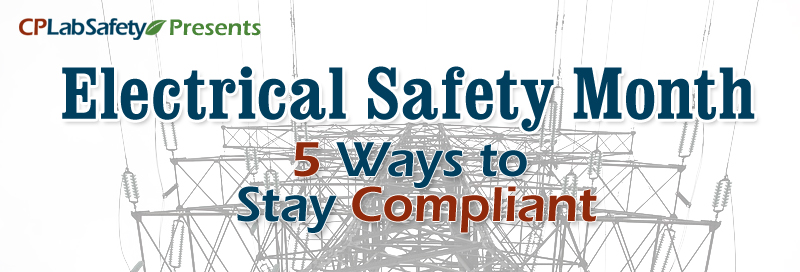Electrical Safety Month: 5 Ways to Stay Compliant

1. Use the correct PPE (Personal Protection Equipment) and tools when working with electricity – Electricity is dangerous. Having the proper safety equipment is the best way to prevent electrical injuries and fatalities. Maintaining quality equipment by performing periodic inspections of all electrical tools can save lives. Inspect cords and plugs for damage. Make sure protective gloves are worn (when appropriate) and wear protective eyewear to defend against sparks and flying debris. Consider anti-static floor matting, grounding wires, and other preventive devices. Prepare and protect against inclement weather, standing water or other potentially dangerous situations. Keep wires covered with sidewinder cable protectors to minimize trip hazards and prevent wires from being damaged by vehicles.
2. Always use caution when working near electricity – Never take safety for granted. Turn off breakers before
 working with wiring and use GFCIs when plugging
in electrical tools to prevent injuries and fatalities. Before digging, check with
Call Before You Dig to make
sure there are no buried electrical lines. (Dial “811” from anywhere in the
country a few days prior to digging. Your call will be routed to your local
call center.)
working with wiring and use GFCIs when plugging
in electrical tools to prevent injuries and fatalities. Before digging, check with
Call Before You Dig to make
sure there are no buried electrical lines. (Dial “811” from anywhere in the
country a few days prior to digging. Your call will be routed to your local
call center.)
3. Never approach fallen power lines – If you come across a down power line anywhere, call 911. Allow yourself a 35 foot distance, as the surrounding area can carry a charge and electrocute you. Stay in your car if you hit and knock down a power line, for the same reason. Puget Sound Energy has detailed information on responding to down power lines.
4. Never assume a wire is safe to touch. Test any circuit first. Use a proper circuit tester to check for voltage before you start working.
5.
Lockout/Tagout
when electrical machinery is undergoing maintenance
Lockout /Tagout should be common practice in any industry doing repairs on
electrical equipment. Failure to perform proper lockout/tagout procedures made
control of hazardous energy the
5th leading
cause of fatalities in 2015
. According to the Electrical Safety Foundation
International, take the following steps to perform a Lockout/Tagout:
- a.Notify all employees about the required lockout.
- b.Shut down equipment following typical procedure.
- c.Locate and disconnect equipment from energy sources.
- d.Release any stored energy.
- e.Lockout all switches and controls with assigned locks and tags.
- f.After verifying that no personnel are exposed, test the normal operating controls to ensure the equipment won’t power on. Make sure to return the equipment to the “off” position after testing.
- g.Perform any necessary servicing.
- h.Remove the lockout device.
- i.Once work is completed, notify all employees.
According to OSHA, following proper Lockout / Tagout procedures could prevent an estimated 120 fatalities and 50,000 injuries a year.
Lockout/Tagout OSHA training video:
According to the
Electrical Safety
Foundation International
, “Increasing
awareness of electrical safety hazards and understanding the importance of
following a comprehensive electrical safety program are the critical first for
improving the electrical safety of your workplace.“
CP Lab Safety offers Safety Training DVDs and booklets to
help teach
OSHA
General Electrical Safety guidelines
for the workplace. “Keeping
people healthy and safe”
is our Corporate Mission Statement.
For more safety training, visit
www.cplabsafety.com/lab-safety-training/.
EHS Today, Electrical Safety Month: http://ehstoday.com/safety/national-electrical-safety-month-address-common-workplace-electrical-hazards
OSHA, Electrical Safety: https://www.osha.gov/Publications/electrical_safety.html
EFSI, Lockout / Tagout: http://www.esfi.org/resource/lockout-tagout-your-life-depends-on-it-544
Recent Posts
-
Disinfecting Surfaces in the Era of Covid and EPA Registered Commercial Disinfectants and Viricides
The disinfection of surfaces at home, in public spaces, and in hospitals and clinics needs to be a …15th Jan 2023 -
Working with Inorganic Acids in the Laboratory: A Practical Guide
Working with Inorganic Acids in the LaboratoryAcids are of great importance in the laboratory and ar …4th Jan 2023 -
The Top 12 Drinking Water Contaminants
1.Lead- from older plumbing systems pre-1986, when lead pipes, solder, and components were banned. …14th Dec 2022
